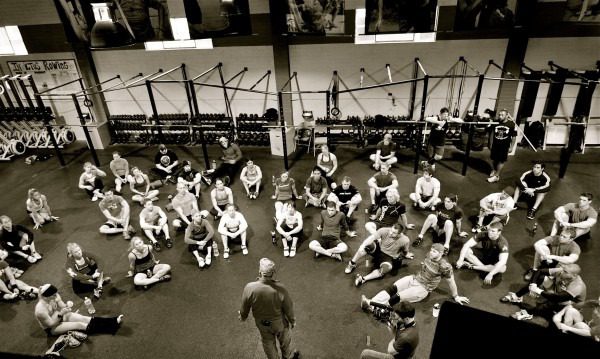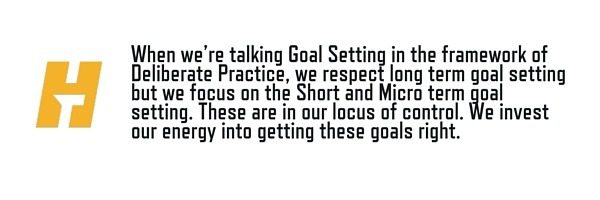Goal Setting for Coaches: 4 Powerful Principles That Deliver Results
Coach DevelopmentABOUT THE AUTHOR

Ben Crookston
Ben Crookston is the Founder and CEO of TrainHeroic. Prior to finding his home in the tech world, Ben ordered the Sampler off the career menu, teaching, coaching, and writing. He has an incredible family and back squats 500 pounds A2G.

83% of the US Population does not set goals and of the 17% who actually set goals only 30% actually achieve them.
That works out to about 5 out of 100 people who actually achieve their goals.
When we think of “goal setting,” as humans, we have an overwhelming propensity to think of long term, way-off-on-the-horizon, bucket list type goals.
But here’s the deal. Those goals are nearly impossible to hit with consistency. They’re too far away. There are too many variables we haven’t considered and could never predict.
Nailing one of these NYE type goals is like snipering a tin can from 400 yards out…in 50 mph winds…while a seductive siren-feather tickles your ear. It ain’t gonna happen and it’s a demoralizing cycle to live in.
The further the target, the less likely we’ll hit it. Like Al Pacino said, “Life is a game of inches.”
When we’re talking Goal Setting in the framework of Deliberate Practice, we respect long term goal setting and recognize its utility for clarifying vision, but we focus on the Short and Micro term goal setting.
These are in our locus of control. We invest our energy into getting these goals right.

In your coaching, Short Term Goals are goals related to a cycle, month, or week of training.
Micro Term Goals are goals related to one single day of training or, even better, a singular training activity.
What follows are 4 principles to follow when setting short term and micro term goals for your athletes.
1. Focus on Behaviors, Not Outcomes
Focus on your locus.
You can’t control the outcome (you can only influence it), but you can control the behavior.
Therefore, think, “what would it take to accomplish my desired outcome?” then make a goal to achieve that behavior with devastating consistency.
The inches will add up.
Rather than, “On average athletes will increase their 3RM back squat by 10lbs this cycle,” think “Athletes will hit full depth on 100% of their prescribed squats this cycle.”
The former is an outcome you can influence, but not control. The latter is within your control and leads to the desired outcome (assuming reasonable programming, consistent athlete effort, etc.).
Focus on your locus.

2. Repeat, Repeat, Repeat
Much of effective goal setting with athletes is repetitively communicating the target prior to the task so it remains top of mind during the training activity.
Repeat the goal aloud before, during, and after athletes perform the activity so your words are melded to the motor units being recruited.
What should athletes be looking for? How do they know if they’re succeeding?
Every workout is a fresh opportunity to remind your athletes where their focus should be.
Take advantage of it.
3. Be S.M.A.R.T
As mentioned earlier, when people think about goals, they have a habit about projecting way into the future.
This effect is compounded in the act of setting SMART Goals (Specific, Measurable, Attainable, Relevant, Time-bound)… perhaps it’s something about the “T” for time- bound, that makes them cast their goals way into the distance.
In “Practice Perfect”, master instructor Doug Lemov recants a story about the Spanish National soccer team vastly improving their ability to control the clock by establishing a goal based training activity:
“When you turn the ball over, fight to win the ball back within 6 seconds.”
This goal is a discrete, trainable behavior with a time-bound and measurable outcome. Better yet, it’s relevant, since prior to rolling out this training activity, ball control was a central flaw in the Spanish game.
Each time you’re starting an activity, think: What would mastery of this activity look like? Make it SMART.

4. Challenge Appropriately
If athletes aren’t driven by the targets you’re setting, they’ll stagnate. In line with the main theme of Deliberate Practice, set goals just outside the comfort zone of the athlete to make ‘em count.
No “gimmes” and no “gotchas.” Goals should neither be so easily attainable that they’re unrewarding, nor so lofty and unreachable that they’re demoralizing.
Make goals just beyond their reach.
The right balance creates a flow state that puts athletes in a trance of engagement and keeps them hooked on their practice.
One element in the strength world that accomplishes this perfectly is linear progression. With each passing week, push them up, up, and up…when they falter, deload them, and build them back up again.
Are you a better coach after reading this?
More coaches and athletes than ever are reading the TrainHeroic blog, and it’s our mission to support them with useful training & coaching content. If you found this article useful, please take a momemnt to share it on social media, engage with the author, and link to this article on your own blog or any forums you post in.
Be Your Best,
TrainHeroic Content Team
HEROIC SOCIAL
HEROIC SOCIAL
TRAINING LAB
Access the latest articles, reviews, and case studies from the top strength and conditioning minds in the TH Training Lab

